WordPress is written utilizing PHP as its scripting language and MySQL as its database administration system. To be able to use WordPress, you don’t actually need to study both of them.
Nonetheless, a really fundamental understanding of the 2 may assist you troubleshoot issues in addition to improve your understanding of how WordPress works (behind the scenes).
On this article, we are going to clarify how WordPress makes use of the database together with an intro to default WordPress database tables.
We will even present you the right way to handle a WordPress database utilizing phpMyAdmin which can embody creating database backups, optimizing the WordPress database, and extra.
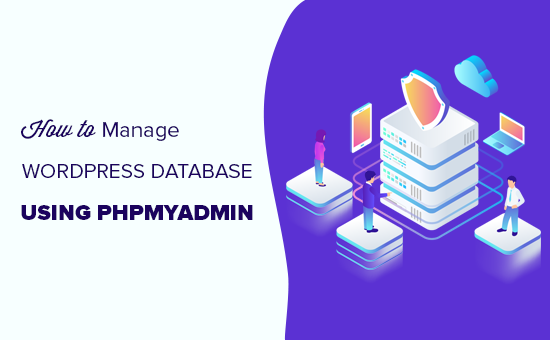
What's a Database and How WordPress Makes use of it?
A database is a system of storing and fetching knowledge in an organized manner. Database permits software program to handle knowledge in a programmable manner.
For instance: WordPress makes use of PHP (programming language) to retailer and retrieve knowledge from the database.
The data saved in a WordPress database contains posts, pages, feedback, classes, tags, customized fields, customers, and different WordPress settings. We are going to elaborate on this later within the tutorial once we cowl all WordPress database tables.
Once you first set up WordPress, it asks you to offer a database identify, host, username, and password. This info is saved within the configuration file referred to as wp-config.php.
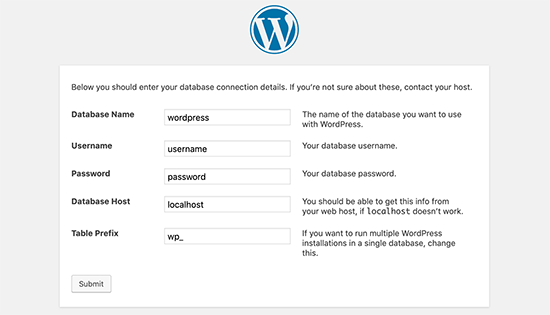
Through the set up, WordPress makes use of the knowledge you present in regards to the database to create tables and retailer default set up knowledge inside these tables.
After the set up, WordPress runs queries to this database to dynamically generate HTML pages to your web site or weblog.
That is what makes WordPress extraordinarily highly effective since you don’t need to create a brand new .html file for every web page that you just need to create. WordPress handles every part dynamically.
The place is my WordPress database saved?
WordPress makes use of MySQL as its database administration system, which is a software program put in in your WordPress internet hosting server. Your WordPress database can also be saved on the identical server.
This location nevertheless will not be accessible on most shared internet hosting environments. Nonetheless, if you're on a VPS internet hosting plan or a devoted server, then you need to use command line instruments to find the database.
Most frequently it's situated on the following path:
/var/lib/mysql/your_database_name
Nonetheless, this might differ from one internet hosting supplier to a different.
It is very important needless to say you don’t actually need to entry the database file itself. You should utilize different instruments like phpMyAdmin to handle your database.
What's phpMyAdmin?
PhpMyAdmin is a web-based software program that permits you to handle MySQL databases utilizing your net browser. It gives a straightforward to make use of interface that permits you to run MySQL instructions and database operations.
You may as well use it to browse and edit database tables, rows, and fields. It additionally permits you to import, export, or delete all knowledge inside a database.
Methods to Entry PhpMyAdmin?
PhpMyAdmin comes pre-installed with all high WordPress internet hosting firms. You'll find it below the Databases part of your internet hosting account’s cPanel dashboard. Under is an instance screenshot from Bluehost management panel:

Relying in your internet hosting supplier, your cPanel interface could look totally different than the above screenshot. You'll nonetheless have the ability to discover phpMyAdmin icon below the databases part.
Clicking on it is going to open the phpMyAdmin interface the place you may choose your WordPress database from the left column. After, that phpMyAdmin will show all tables in your WordPress database.
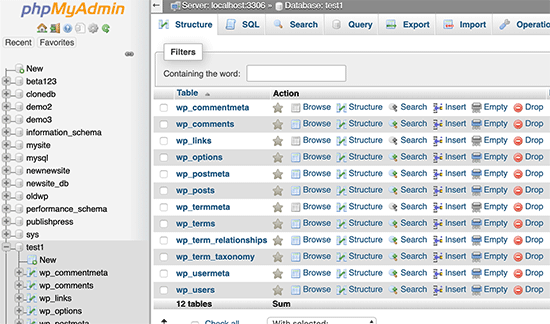
Let’s check out the WordPress database tables.
Understanding WordPress Database Tables
Every WordPress set up has 12 default tables within the database. Every database desk comprises knowledge for various sections, options, and performance of WordPress.
Trying on the construction of those tables, you may simply perceive the place totally different components of your web site are saved. At present, a default WordPress set up creates the next tables:
Notice: wp_ earlier than every desk identify is the database prefix you select through the set up. It may be totally different when you modified it on the time of set up.
wp_commentmeta : This desk comprises meta details about feedback posted on a WordPress web site. The desk has 4 fields meta_id, comment_id, meta_key, and meta_value. Every meta_id is said to a comment_id. One instance of remark meta info saved is the standing of remark (accredited, pending, trash, and so forth).
wp_comments : Because the identify suggests this desk comprises your WordPress feedback. It comprises remark creator identify, url, electronic mail, remark, and so forth.
wp_links : To handle blogrolls create by earlier variations of WordPress or the Hyperlink Supervisor plugin.
wp_options : This desk comprises most of your WordPress site-wide settings equivalent to: web site url, admin electronic mail, default class, posts per web page, time format, and far far more. The choices desk can also be utilized by quite a few WordPress plugins to retailer plugin settings.
wp_postmeta : This desk comprises meta details about your WordPress posts, pages, and customized publish sorts. Instance of publish meta info could be which template to make use of to show a web page, customized fields, and so forth. Some plugins would additionally use this desk to retailer plugin knowledge equivalent to WordPress search engine optimization info.
wp_posts : The identify says posts however really this desk comprises all publish sorts or ought to we are saying content material sorts. This desk comprises all of your posts, pages, revisions, and customized publish sorts.
wp_termmeta : This desk permits builders to retailer customized metadata for phrases below their customized taxonomies. For instance, WooCommerce makes use of it to retailer metadata for product attributes and classes.
wp_terms : WordPress has a strong taxonomy system that permits you to set up your content material. Particular person taxonomy gadgets are referred to as phrases, and they're saved on this desk. For instance, your WordPress classes and tags are taxonomies, and every class / tag inside them is a time period.
wp_term_relationships : This desk manages relationship of WordPress publish sorts with phrases in wp_terms desk. For instance that is the desk that helps WordPress decide publish X is in Y class.
wp_term_taxonomy : This desk defines taxonomies for phrases outlined in wp_terms desk. For instance, you probably have a time period “WordPress Tutorials“, then this desk comprises the info that claims it's related to a taxonomy referred to as class. In brief, this desk has the info that helps WordPress differentiate between which time period is a class, which is a tag, and so forth.
wp_usermeta : Comprises meta details about registered customers in your web site.
wp_users : Comprises consumer info like username, password, consumer electronic mail, and so forth.
Managing WordPress Database utilizing phpMyAdmin
Your WordPress database comprises essential WordPress settings, all of your weblog posts, pages, feedback, and extra. You might want to be extraordinarily cautious when utilizing phpMyAdmin, or you could find yourself by chance deleting essential knowledge.
As a precaution, it is best to all the time create a full database backup. This might help you restore your database the best way it was earlier than.
Let’s check out the right way to simply create a WordPress database backup.
Making a WordPress Database Backup utilizing phpMyAdmin
To create a backup of your WordPress database from phpMyAdmin, click on in your WordPress Database. On the highest menu, click on on the Export tab.
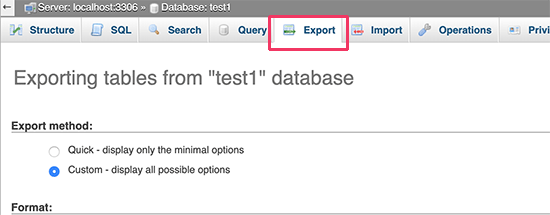
In newer variations of phpMyAdmin, it is going to ask you for an export technique. The fast technique will export your database in a .sql file. Within the customized technique, it is going to offer you extra choices and skill to obtain backup in compressed zip or gzip archive.
We suggest utilizing the customized technique and selecting zip because the compression technique. The customized technique additionally permits you to exclude tables from the database.
Let’s say when you used a plugin that created a database desk, and you might be not utilizing that plugin, then you may select to exclude that desk from the backup if you need.
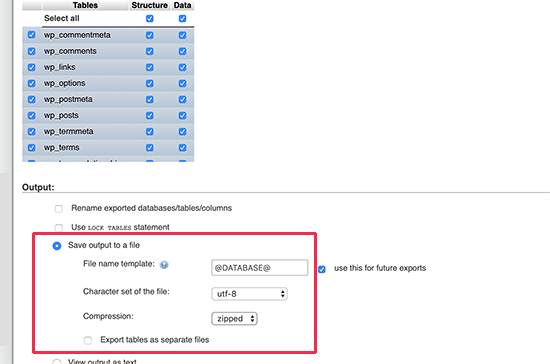
Your exported database file will be imported again into a unique or the identical database utilizing phpMyAdmin’s import tab.
Making a WordPress Backup utilizing a Plugin
Conserving common backups of your WordPress web site is one of the best factor you are able to do to your WordPress safety. Whereas the WordPress database comprises the vast majority of your web site info, it nonetheless lacks a number of pretty essential components equivalent to template information, photos, uploads, and so forth.
All of your photos are saved within the uploads folder in your /wp-content/ listing. Despite the fact that the database has the knowledge which picture is connected to a publish, it's ineffective if the picture folder doesn’t have these information.
Typically freshmen suppose that the database backup is all that they want. It's NOT true. You might want to have a full web site backup that features your themes, plugins, and pictures.
Whereas most internet hosting firms declare they've each day backups, we suggest that you just preserve backups your self simply in case.
Notice: In case you are on a managed WordPress internet hosting answer like WPEngine, then they do create each day backups.
Importing a WordPress Database Backup through phpMyAdmin
PhpMyAdmin additionally permits you to simply import your WordPress database. Merely launch phpMyAdmin after which choose your WordPress database.
Subsequent, it's essential to click on on the ‘Import’ hyperlink from the highest menu.
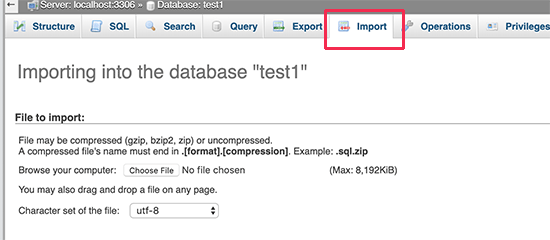
On the following display, click on on the Select file button after which choose your database backup file you downloaded earlier.
PhpMyAdmin will now course of your backup file add and import it into your WordPress database. As soon as completed, you will note successful message.
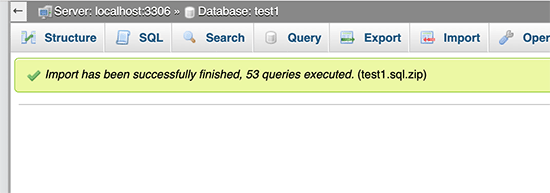
Optimizing your WordPress Database in phpMyAdmin
After utilizing WordPress for some time, your database turns into fragmented. There are reminiscence overheads which improve your total database dimension and question execution time.
MySQL comes with a easy command that permits you to optimize your database. Merely go to phpMyAdmin and click on in your WordPress database. This may present you a listing of your WordPress tables.
Click on on the examine All hyperlink under the tables. Subsequent to it, there's a “With Chosen” drop down, it's essential to click on on it and select Optimize desk.
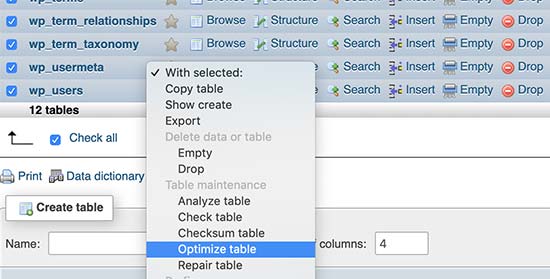
This may optimize your WordPress database by defragmenting chosen tables. It can make your WordPress queries run a little bit sooner and barely scale back the scale of your database.
Fixing WordPress Points utilizing PhpMyAdmin
As we talked about earlier, phpMyAdmin is a helpful device for troubleshooting and fixing some frequent WordPress errors and points.
Let’s take a look at some frequent WordPress points that may be simply fastened utilizing phpMyAdmin.
Reset WordPress Password Utilizing PhpMyAdmin
In the event you forgot your WordPress admin password and can't get better it through misplaced password electronic mail, then this technique permits you to shortly reset WordPress password.
First, launch the phpMyAdmin and choose your WordPress database. This may show your WordPress database tables the place it's essential to browse subsequent to wp_users desk.
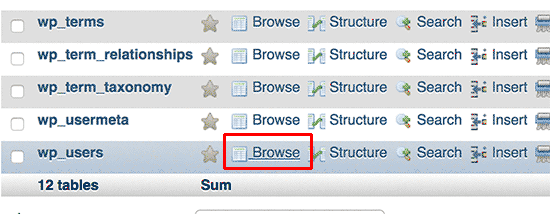
Notice: Desk names in your WordPress database could have a unique desk prefix than the one we're displaying in our screenshot.
You'll now see the rows in your WordPress customers desk. Go forward and click on on the edit button subsequent to the username the place you need to change the password.

PhpMyAdmin will present you a type with all of the consumer info fields.
You will have to delete the worth within the user_pass discipline and exchange it along with your new password. Underneath the perform column, choose MD5 from the drop-down menu and click on on the Go button.
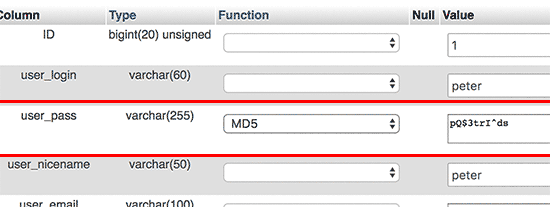
Your password might be encrypted utilizing the MD5 hash after which it is going to be saved within the database.
Congratulations! You've efficiently modified your WordPress password utilizing phpMyAdmin.
Now a few of you could be questioning why did we choose the MD5 hash to encrypt the password.
Within the older model, WordPress used MD5 hash to encrypt passwords. Since WordPress 2.5, it began utilizing stronger encryption applied sciences. Nonetheless, WordPress nonetheless acknowledges MD5 to offer backward compatibility.
As quickly as you log in utilizing a password string saved as an MD5 hash, WordPress acknowledges it and adjustments it utilizing the newer encryption algorithms.
Including a New Admin Consumer to WordPress utilizing PhpMyAdmin
Let’s suppose you've got entry to the WordPress database however not the WordPress admin space. Whilst you can change the admin consumer password, it is going to forestall the opposite admin consumer from utilizing their account.
A neater answer could be so as to add a brand new admin consumer through phpMyAdmin.
First, it's essential to launch the phpMyAdmin after which choose your WordPress database. This may present your WordPress database tables the place it's essential to click on on the ‘Browse’ hyperlink subsequent to wp_users desk.

phpMyAdmin will now present you the rows contained in the wp_users desk. Go forward and click on on the ‘Insert’ hyperlink from the menu on the highest.
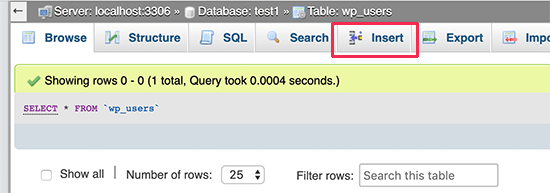
This may convey up a type that it's essential to replenish so as to add a brand new consumer to your WordPress web site.
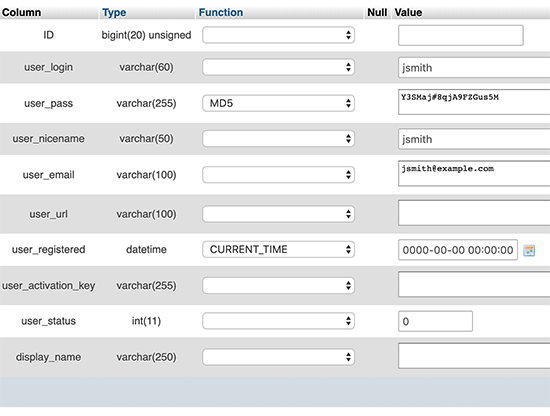
Right here is how it's essential to fill every discipline on this type.
- ID – You possibly can ignore this one as that is routinely generated.
- user_login – This might be your WordPress username that you just’ll use to login.
- user_pass – That is your WordPress password it's essential to enter the password and choose MD5 within the perform column.
- user_nicename – That is the URL pleasant username you need to use the as your login.
- user_email – Enter a legitimate electronic mail deal with as you could want it to recieve password reset and WordPress notification emails.
- user_url – Add your web site URL or you may go away it clean.
- user_registered – You might want to choose the CURRENT_TIME within the perform column to routinely insert present time right here.
- user_activation_key – You possibly can go away this discipline clean as effectively it's used to approve consumer registeration.
- user_status – You possibly can go away this discipline clean as effectively.
- display_name – You possibly can enter the consumer’s full identify as you need to be displayed on the articles. You may as well go away it clean.
After filling within the type, click on on the Go button to insert it into your WordPress database. PhpMyAdmin will now run the MySQL question to insert the info.
Now we have added the consumer, however that consumer doesn't have an administrator consumer function in your WordPress web site. This worth is saved in one other desk referred to as wp_usermeta.
Earlier than we will make this consumer an administrator, we might want to discover the consumer ID. Merely click on on the ‘Browse’ hyperlink subsequent to wp_users desk and you will note a row containing your newly added consumer with their consumer ID.
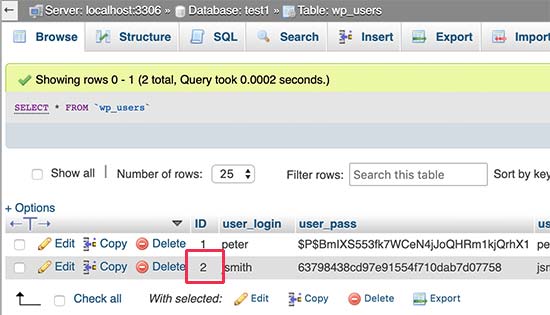
Notice down the consumer ID as you’ll want it within the subsequent step.
Now, let’s open the wp_usermeta desk by clicking on the Browse hyperlink subsequent to it.

Subsequent, it's essential to click on on the Insert hyperlink on the high so as to add a brand new row to the desk.

You’ll now see a type to enter a brand new row. That is the place you’ll inform WordPress that the consumer you created earlier has the administrator consumer function.
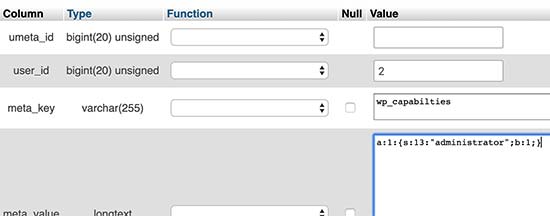
Right here is the way you’ll fill on this type.
- umeta_id – You might want to go away it clean as it's routinely crammed in.
- user_id – Enter the consumer ID you copied earlier.
- meta_key – You might want to enter wp_capabilities on this discipline. Nonetheless, you could want to interchange wp_ in case your WordPress desk names use a unique prefix.
- meta_value – You might want to enter the next serialized worth:
a:1:{s:13:"administrator";s:1:"1";}
Lastly, click on on the Go button to avoid wasting your adjustments.
Subsequent, we have to add one other row to outline the consumer stage. Click on on the Insert hyperlink on the highest menu so as to add one other row to the usermeta desk.
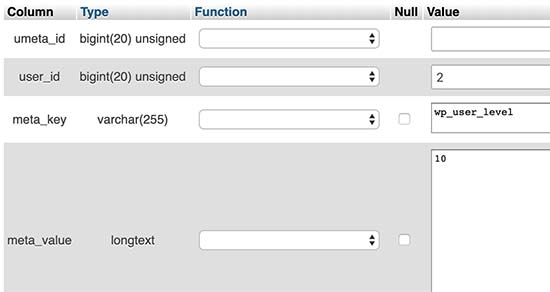
Right here is the way you’ll fill on this type.
- umeta_id – You might want to go away it clean as it's routinely crammed in.
- user_id – Enter the consumer ID to your newly added consumer.
- meta_key – You might want to enter wp_user_level on this discipline. Nonetheless, you could want to interchange wp_ in case your WordPress desk names use a unique prefix.
- meta_value – Right here it's essential to enter 10 because the consumer stage worth.
Don’t overlook to click on on the Go button to insert the info.
That’s all, now you can go to the WordPress admin space and log in along with your newly added admin consumer.
Change a WordPress Username through PhpMyAdmin
You'll have seen that whereas WordPress help you change consumer’s full identify or nickname, it doesn't help you change the username.
Now a whole lot of customers find yourself selecting usernames through the set up that they might later need to change. Right here is how you are able to do this through phpMyAdmin.
Notice: there may be a better technique to change WordPress username utilizing a plugin.
First, it's essential to launch the phpMyAdmin out of your internet hosting account’s cPanel dashboard. After that, it's essential to choose your WordPress database.
PhpMyAdmin will present your WordPress database tables. You might want to click on on the ‘Browse’ hyperlink subsequent to wp_users desk.

This desk will now record all of the registered customers in your web site. Click on on the edit hyperlink subsequent to the username that you just need to change.

PhpMyAdmin will now present you the consumer knowledge. You might want to find the user_login discipline and alter the worth to the username you need to use.
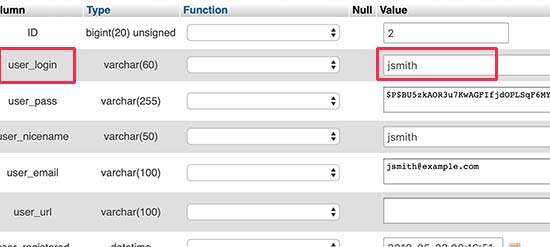
Don’t overlook to click on on the Go button to avoid wasting your adjustments. Now you can go to your web site and login along with your new username.
Different Helpful PhpMyAdmin Tips
Your WordPress database is the engine behind your web site. With phpMyAdmin you may tweak settings to enhance efficiency, repair points, or just change issues that can't be modified from inside WordPress admin space.
Securing your WordPress Database
Earlier than we get into this, we need to emphasize that each web site will be hacked. Nonetheless, there are specific measures you may take to make it a little bit more durable.
Very first thing that you are able to do to is to change WordPress database prefix. This may considerably scale back the probabilities of SQL injection assaults in your WordPress database as a result of typically hackers goal websites in plenty the place they're focusing on the default wp_ desk prefix.
It is best to all the time select a robust username and password to your MySQL consumer. This may make it tough for somebody to get entry to your WordPress database.
For WordPress safety, we strongly suggest that you just use Security. It's the finest WordPress safety plugin that may catch any makes an attempt at MySQL injection even earlier than it reaches your web site.
We hope that this information helped you study WordPress database administration and the right way to use phpMyAdmin.
Comments
Post a Comment